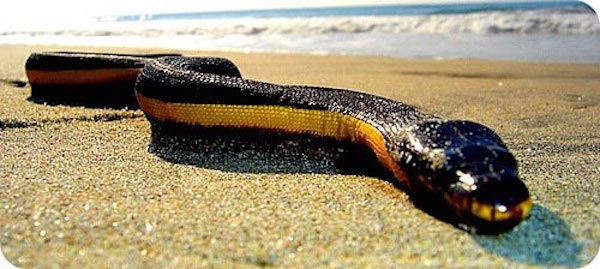
Beachgoers in California have more to worry about than shark attacks as there are now venomous sea snakes washing ashore.
For the first time in 30 years or more, a poisonous sea snake has been spotted on a beach in Southern California. It was apparently drawn far north of its usual habitat by what environmental groups think are the warming ocean waters because of El Niño.

BYPASS THE CENSORS
Sign up to get unfiltered news delivered straight to your inbox.
You can unsubscribe any time. By subscribing you agree to our Terms of Use
Latest Video
Yahoo News reports:.
On Friday, a surfer found a yellow-bellied sea snake slithering in the sand at Silver Strand beach in Ventura County, about an hour north of Los Angeles, the Los Angeles Times reports.
It’s the furthest north along the Pacific Coast of North America that the black and yellow sea snake Pelamis platurus has ever been spotted, and the first time it’s been seen in California since 1985—which was also an El Niño year.
The snake is typically found in warm tropical waters, which, owing to this year’s El Niño conditions, California beaches now provide. The snakes don’t travel well on land, and the captured yellow-bellied snake died in transport to the local U.S. Fish and Wildlife Service office, according to the Times.
El Niños occur every two to seven years, disrupting winter weather across the country. Scientists have linked rising global temperatures to more severe El Niño events. The National Oceanic and Atmospheric Administration lists this year’s El Niño as one of the strongest on record—and it’s hurting more wildlife than just one scary snake.
A Boon for Fishermen, a Bummer for Tropical Fish
A few miles off of San Diego, fishermen are reeling in exotic fish such as bluefin tuna, yellowtail, and dorado. Though these fish are typically found in Mexico, the four- to five-degree increase in water temperature has created a successful fishing season for Southern California, PBS reports.
Crustacean Crisis
Thousands of crabs found their way to shore in San Diego and Orange County, California, this summer, according to KTLA. Prompted to travel north owing to El Niño–triggered warm weather, the crabs struggle out of water, leaving the beaches coated in dead red crustaceans.
Struggling Seabirds
Seabirds are dying at an alarming rate in Northern California, according to the Sacramento Bee. The International Bird Rescue Center has seen an influx in starved common mures, which typically feast on fish below the surface. The warm waters have pushed the fish deeper into cold waters, and the mures simply can’t reach them.
The Phytoplankton Effect
A whole host of marine animals feast on phytoplankton, including whales, jellyfish, and shrimp. As El Niño weakens upwelling of cool nutrient-rich water to the ocean surface, the amount of phytoplankton decreases. Because phytoplankton make up the bottom of the ocean’s food web, decreased supplies affect not only the fish that eat them but those animals’ predators as well. The appearance of hammerhead sharks in waters off the California coast in recent months is because of an increased hunt for food sources, mainly smaller fish and squid, according to wildlife experts.


